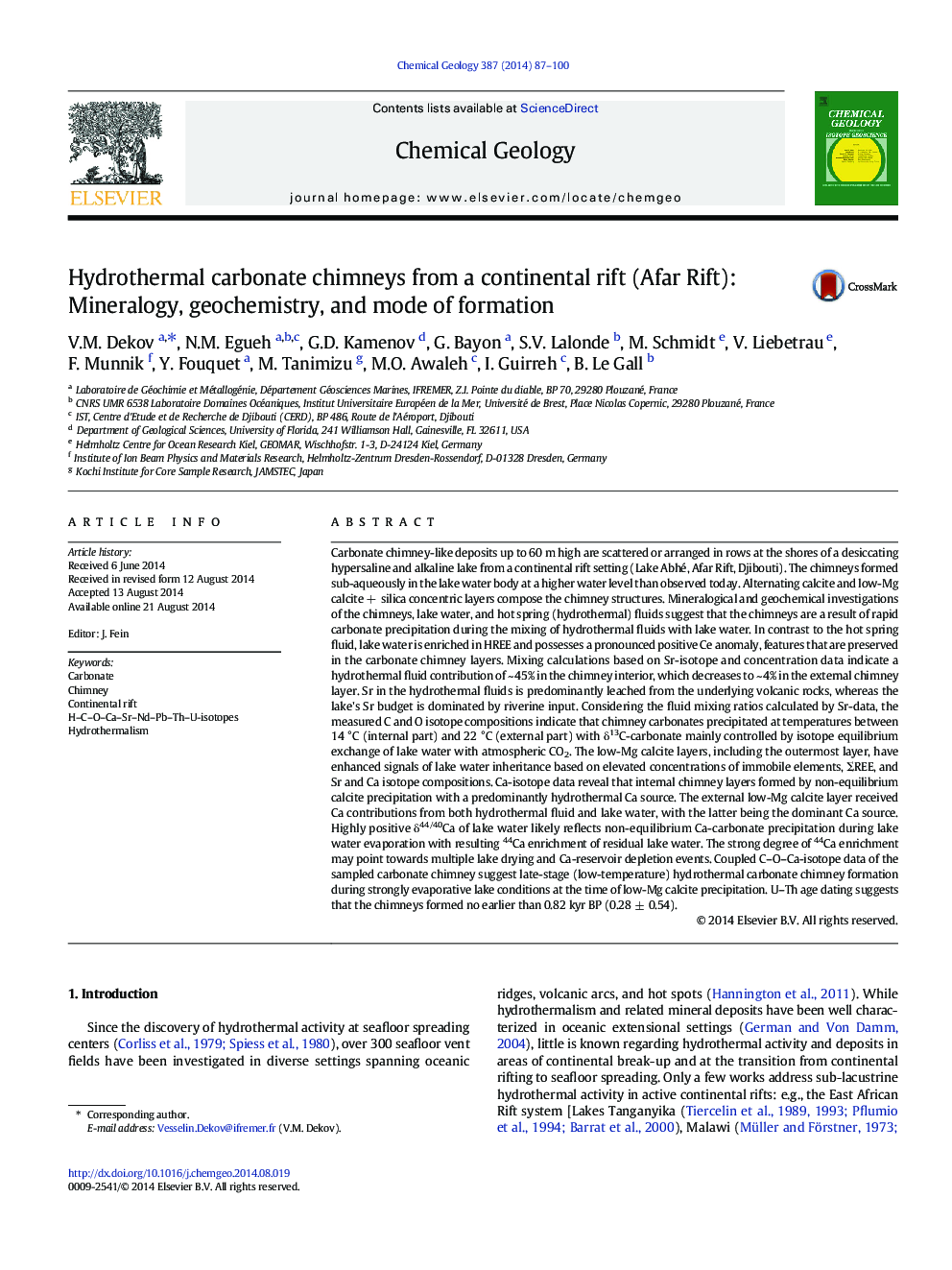| کد مقاله | کد نشریه | سال انتشار | مقاله انگلیسی | نسخه تمام متن |
|---|---|---|---|---|
| 6436568 | 1637585 | 2014 | 14 صفحه PDF | دانلود رایگان |
- Giant (up to 60Â m high) chimney-like carbonate deposits formed in a continental rift.
- Chimneys formed sub-aqueously in a desiccating hypersaline and alkaline lake.
- They are a result of carbonate precipitation during mixing hydrothermal fluids-lake water.
- There is a dominant lake water control on deposition of chimney exterior.
- The chimneys formed recently: ~ 0.28 ± 0.54 kyr BP.
Carbonate chimney-like deposits up to 60 m high are scattered or arranged in rows at the shores of a desiccating hypersaline and alkaline lake from a continental rift setting (Lake Abhé, Afar Rift, Djibouti). The chimneys formed sub-aqueously in the lake water body at a higher water level than observed today. Alternating calcite and low-Mg calcite + silica concentric layers compose the chimney structures. Mineralogical and geochemical investigations of the chimneys, lake water, and hot spring (hydrothermal) fluids suggest that the chimneys are a result of rapid carbonate precipitation during the mixing of hydrothermal fluids with lake water. In contrast to the hot spring fluid, lake water is enriched in HREE and possesses a pronounced positive Ce anomaly, features that are preserved in the carbonate chimney layers. Mixing calculations based on Sr-isotope and concentration data indicate a hydrothermal fluid contribution of ~ 45% in the chimney interior, which decreases to ~ 4% in the external chimney layer. Sr in the hydrothermal fluids is predominantly leached from the underlying volcanic rocks, whereas the lake's Sr budget is dominated by riverine input. Considering the fluid mixing ratios calculated by Sr-data, the measured C and O isotope compositions indicate that chimney carbonates precipitated at temperatures between 14 °C (internal part) and 22 °C (external part) with δ13C-carbonate mainly controlled by isotope equilibrium exchange of lake water with atmospheric CO2. The low-Mg calcite layers, including the outermost layer, have enhanced signals of lake water inheritance based on elevated concentrations of immobile elements, ΣREE, and Sr and Ca isotope compositions. Ca-isotope data reveal that internal chimney layers formed by non-equilibrium calcite precipitation with a predominantly hydrothermal Ca source. The external low-Mg calcite layer received Ca contributions from both hydrothermal fluid and lake water, with the latter being the dominant Ca source. Highly positive δ44/40Ca of lake water likely reflects non-equilibrium Ca-carbonate precipitation during lake water evaporation with resulting 44Ca enrichment of residual lake water. The strong degree of 44Ca enrichment may point towards multiple lake drying and Ca-reservoir depletion events. Coupled C-O-Ca-isotope data of the sampled carbonate chimney suggest late-stage (low-temperature) hydrothermal carbonate chimney formation during strongly evaporative lake conditions at the time of low-Mg calcite precipitation. U-Th age dating suggests that the chimneys formed no earlier than 0.82 kyr BP (0.28 ± 0.54).
Journal: Chemical Geology - Volume 387, 10 November 2014, Pages 87-100
